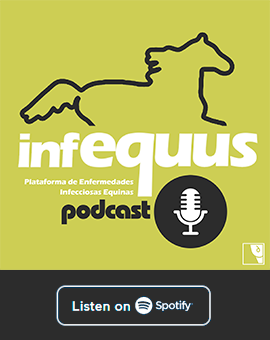Equine herpesvirus type 5
Etiology
The etiology of this disease is not clear, although equine gammaherpesvirus type 5, belonging to the genus Percavirus, family Herpesviridae, has been associated with equine multinodular pulmonary fibrosis. Recent studies have also detected coinfection with asinine herpervirus, and there are also cases of the disease where only asinine herpervirus has been isolated; therefore there may be a synergism of differentgammaherpesvirus in the pathogenesis of this disease.
Epidemiology
The virus has a worldwide distribution with high prevalence, it has been detected both in healthy animals and in animals with clinical signs. The infection usually occurs in young animals, but later than in the case of equine herpesvirus type 2 and the infection usually lasts over time.
Pathogeny
Infection with this virus usually does not produce clinical signs. The infection is produced by inhalation of viral particles, which replicate in the mucosa of the upper respiratory tract and invade the B lymphocytes that spread the infection through the rest of the organism. EHV-5 can remain latent in lymphocytes and in trigeminal ganglion and be reactivated due to stress or immunodepression.
Clinical signs
The disease is usually present in adult horses. The clinical signs are fever, cough, nasal discharge, tachypnea, tachycardia, weight loss and intolerance to exercise. In some cases clinical signs are mild at the beginning and they may be misdiagnosed with equine asthma. Other signs less frequently observed are lymphadenopathy, keratoconjuntivitis, oral ulcers and pain associated to movement.
Lung auscultation reveals crackles and wheezes. As with other interstitial pneumoniae, the possibility of the development of pulmonar hypertension and associated cor pulmonale must be taken into account; fibrosis in other organs such as liver and heart has also been described.
Frequent haematological abnormalities are anaemia, neutrophilia, lymphopenia, hyperfibrinogenemia and hipoalbuminemia; it can also curse with increases in serum A Amiloid and in some cases pancytopenia has been reported, although this is not very frequent.
Diagnosis
The clinical diagnosis consists of observing the presence of the clinical signs described above, together with a compatible radiographic image. Using ultrasound and depending on the chronicity of the process, irregularities and thickening of pleurae can be observed. There may be superficial nodules in the lungs and, occasionally, abscesses and areas of consolidation and atelectasis. Lung x-rays show a moderate to severe nodular interstitial pattern, similar to the observed in fungal infections or neoplasia with granuloma. This pattern is more evident in the dorsocaudal region of the lung. A tracheal wash and bronchoalveolar wash (BAL) can also be carried out and a marked inflammation with predominance of neutrophils and mucus, similar to the observed in equine asthma. The detection by PCR of EHV-5 can be carried out in deep nasal swab, blood, tracheal wash or BAL samples, the two latter would be the most appropriate.
The definitive diagnosis is made by microscopic study of the pulmonary lesions (interstitial fibrosis, type II hyperplasia of alveolar epithelial cells, presence of inflammatory cells and macrophages with intracytoplasmic inclusions), together with PCR of the affected lung tissue to demonstrate the presence of the virus. In horses with clinical signs and a negative result to PCR, the disease cannot be excluded, since false negatives have been reported. Up to date and considering the importance of other gammaherpesvirus in this disease, a multiplex nested PCR detecting DNA from any gammaherpesvirus is being used.
Treatment
Treatment is based on the administration of corticoids, antivirals and drugs to minimize pulmonary fibrosis. Corticoids aid to decrease pulmonar inflammation by inhibiting the synthesis of inflammatory cytokines and mediators that induce fibrosis and cellular infiltration. Often, dexamethasone (0,01-0,02 mg/kg every 12/24 h IM,IV), prednisolone (1 mg/kg every 12/24 VO) or methylprednisolone (1 mg/kg every 12/24 h, IM,IV) are used. The use of antivirals such as acyclovir and valacyclovir is based in their efficacy in clinical studies carried out with EHV-1.
Valacyclovir has a bioavailability of 60% VO in horses (30mg/kg every 8 hours) and is the most appropriate antiviral in case of oral administration, although the treatment is expensive. Acyclovir has a low bioavailability VO but is available IV (10 mg/kg every 12 hours IV).
Doxycyclin is the antibiotic to use for the treatment of this disease due to its antimicrobial and antiinflammatory activities (10 mg/kg every 12 hours VO). Other therapeutic options include the administration of intravenous fluids in case of dehydration; keeping the horse in a fresh and well ventilated environment is also benefitial. AINEs can be administered for the management of pain and fever, and intranasal oxygen (10-15 l/min) can be provided to hypoxemic patients.
Prevention and control
It is a virus with ubiquitous distribution, so no vaccines have been developed against it.
Public Health Considerations
This virus is specific to its host, affecting only equids.
References
- Equine InfectiousDiseases. 2014 Elsevier Inc. ISBN: 978-1-4557-0891-8
- Updateon Viral Diseases of the Equine Respiratory Tract
- Gammaherpesvirusesand Pulmonary Fibrosis: Evidence From Humans, Horses, and Rodents
- ExperimentalInduction of Pulmonary Fibrosis in Horses with the Gammaherpesvirus EquineHerpesvirus 5
- Assessment ofquantitative polymerase chain reaction for equine herpesvirus-5 in blood, nasalsecretions and bronchoalveolar lavage fluid for the laboratory diagnosis ofequine multinodular pulmonary fibrosis

